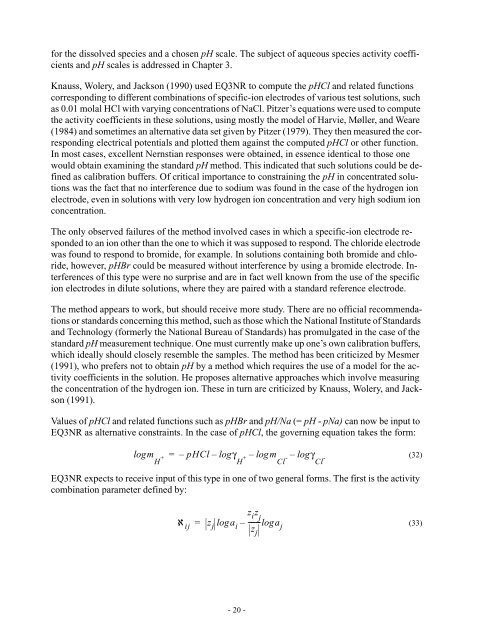EQ3NR, A Computer Program for Geochemical Aqueous Speciation ...
EQ3NR, A Computer Program for Geochemical Aqueous Speciation ...
EQ3NR, A Computer Program for Geochemical Aqueous Speciation ...
Create successful ePaper yourself
Turn your PDF publications into a flip-book with our unique Google optimized e-Paper software.
<strong>for</strong> the dissolved species and a chosen pH scale. The subject of aqueous species activity coefficientsand pH scales is addressed in Chapter 3.Knauss, Wolery, and Jackson (1990) used <strong>EQ3NR</strong> to compute the pHCl and related functionscorresponding to different combinations of specific-ion electrodes of various test solutions, suchas 0.01 molal HCl with varying concentrations of NaCl. Pitzer’s equations were used to computethe activity coefficients in these solutions, using mostly the model of Harvie, Møller, and Weare(1984) and sometimes an alternative data set given by Pitzer (1979). They then measured the correspondingelectrical potentials and plotted them against the computed pHCl or other function.In most cases, excellent Nernstian responses were obtained, in essence identical to those onewould obtain examining the standard pH method. This indicated that such solutions could be definedas calibration buffers. Of critical importance to constraining the pH in concentrated solutionswas the fact that no interference due to sodium was found in the case of the hydrogen ionelectrode, even in solutions with very low hydrogen ion concentration and very high sodium ionconcentration.The only observed failures of the method involved cases in which a specific-ion electrode respondedto an ion other than the one to which it was supposed to respond. The chloride electrodewas found to respond to bromide, <strong>for</strong> example. In solutions containing both bromide and chloride,however, pHBr could be measured without interference by using a bromide electrode. Interferencesof this type were no surprise and are in fact well known from the use of the specificion electrodes in dilute solutions, where they are paired with a standard reference electrode.The method appears to work, but should receive more study. There are no official recommendationsor standards concerning this method, such as those which the National Institute of Standardsand Technology (<strong>for</strong>merly the National Bureau of Standards) has promulgated in the case of thestandard pH measurement technique. One must currently make up one’s own calibration buffers,which ideally should closely resemble the samples. The method has been criticized by Mesmer(1991), who prefers not to obtain pH by a method which requires the use of a model <strong>for</strong> the activitycoefficients in the solution. He proposes alternative approaches which involve measuringthe concentration of the hydrogen ion. These in turn are criticized by Knauss, Wolery, and Jackson(1991).Values of pHCl and related functions such as pHBr and pH/Na (= pH - pNa) can now be input to<strong>EQ3NR</strong> as alternative constraints. In the case of pHCl, the governing equation takes the <strong>for</strong>m:logm + H=– pHCl – logγ + – logm - – logγ -H Cl Cl(32)<strong>EQ3NR</strong> expects to receive input of this type in one of two general <strong>for</strong>ms. The first is the activitycombination parameter defined by:z iz jℵ ij= z jloga i– ------- loga jz j(33)- 20 -
















